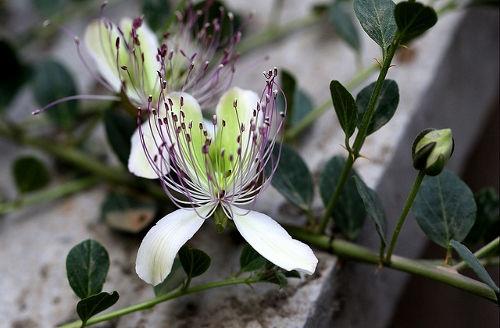What’s Up with That Food: Capers
Paste uncovers the background of foods you've always wondered about
Photo via Flicker/ timlewisnm Food FeaturesThey’re tiny. They’re salty. They look like dark green peas, or wet, pickly lentils. But they’re neither. What they are is something you are going to want to add to your summer dishes. I’m talking about capers. These little guys have a lot of culinary mileage.
Type of food: Edible flower bud
Nicknames/Other names: Slang: Poor Man’s Caviar; Latin: Capparis spinosa
Origins: This perennial edible plant is native to the Mediterranean, East Africa, Madagascar, southwestern and central Asia, the Himalayas, Pacific Islands and Australia.
Why/when did we start eating it: Capers are synonymous with Mediterranean cooking, especially southern Italian, French and Spanish. According to chef Christopher Blobaum of Article 14 in Atlanta, they go way back. “I know they have been used since Roman/Greek times but seeds have been found in tombs 8500 years B.C., possibly as a condiment,” he says. When he lived in California, he had a couple of caper bushes. “They are great in preventing soil erosion because of their long roots and they need little water, which is great for California,” he says. Harvesting capers is a labor-intensive process; they’re so small, they need to be picked by hand.
Some believe the best capers in the world can be found off the coast of Sicily, on the volcanic island of Pantelleria, close to Tunisia. “It’s the minerals and chemicals in the soil that produce the most flavorful buds, in the same way that San Marzano tomatoes owe their rich, meaty flavor to the volcanic soil around Mount Vesuvius, where they are grown,” says Domenica Marchetti, author of six books on Italian cooking, most recently Ciao Biscotti.
How it’s used: Capers are natural fits in pasta dishes with any combination of lemon, artichokes and garlic, or as a tangy add-in to the classic pasta puttanesca. Capers are ready-to-go items in salads (think tuna) or incorporated into a dressing—they’re one of the ingredients in a French-style remoulade, which is a classed-up tartar sauce. Sometimes capers are paired with salmon, and chicken piccata wouldn’t be the same without them.
One of Marchetti’s favorite things is to fry them. “If you fry them in a bit of olive oil, they get crispy and some of them pop open like flowers. They make a great garnish for creamy soups, such as roasted red pepper or tomato soup.” She notes she especially favors the combo of peppers and capers. “When I roast or grill peppers, I’ll toss them with olive oil and lemon, add some sliced garlic and sprinkle capers on top.”
The James Beard Award-nominated chef Todd Gray of Equinox Restaurant in Washington, D.C., takes care when he uses the larger ones. “You have to be sure they are washed very well and they have to be used more sparingly because their flavor is aggressive.” He also employs them in a pineapple caper butter with pan-fried oysters.
Chef/owner Mat Schuster of the Spanish restaurant Canela in San Francisco has his preferences, too. “One of the ways I like to incorporate this indigenous Iberian ingredient is in a savory summer tomato gazpacho with Spanish capers, olives and Piparra peppers.”

Photo of caper blossoms via Flickr/ninara
How it’s purchased: Capers are typically sold in tiny jars, swimming in a pickly brine. They come in a variety of sizes—small, large and as caper berries. (The small ones are sometimes referred to as nonpareils.) “If I want to scatter them whole as a garnish I might use the smaller ones. They are less mature and crunchier, so they add a bit of flavor and texture. If I’m putting them in a sauce or dressing that requires chopping or mincing them, I go for the slightly bigger, softer ones,” Marchetti says.
Bigger still are the caper berries, which are actually the fruit of the plant. If the bud isn’t picked, it flowers and later produces caper berries, which are about the size of olives. Marchetti says they can be pickled or brined and used as a cocktail garnish. Some chefs like to slice them crosswise to expose the seeds inside.
You may be also find salt-cured capers; they offer a more intense flavor—and a more expensive price. Chef Gray says they’re “fantastic for marinating peppers for things like antipasti.”
Chef Blobaum prefers the smaller (nonpareil) variety, packed in salt and not a brine. “They have a much better flavor,” he says. Like Marchetti, he cites salsa verde as a classic use, along with combining them with bread crumbs or cubes cooked in olive oil, and used as a garnish for fish and poultry.
You may be also find those salt-cured capers online or in specialty shops. They present a more intense flavor—and a more expensive price. Chef Gray says they’re “fantastic for marinating peppers for things like antipasti.”
Sensory experience: Capers pack tiny, acidic and salty punch. Rinse, drain them and pat them dry before using, but if you forget it’s not the end of the world. A quick fry in olive oil helps to curb the slight tinny flavor of brine-packed capers.
Nutrition and other benefits: You aren’t going to turn to capers for their vast nutritional stores. They are salty more than anything, with trace amounts of folate, calcium, potassium, magnesium, selenium and Vitamin A.
Other info: In Greek medicine, a traditional tea made with caper root and young shoots is thought to aid rheumatism.
Carrie Havranek is a recovering music critic and part-time baker who writes about food, farmers’ markets, chefs and restaurants—and sometimes travel—from her home in Easton, Pennsylvania. You may have seen her work elsewhere in Edible Philly, the Kitchn, or Frommer’s.